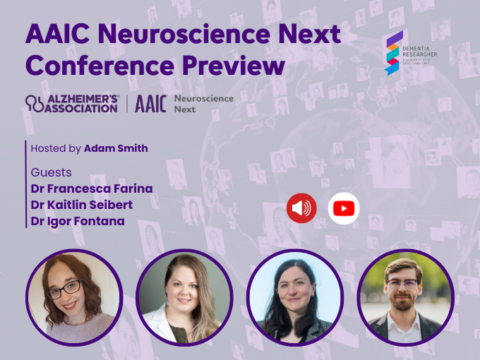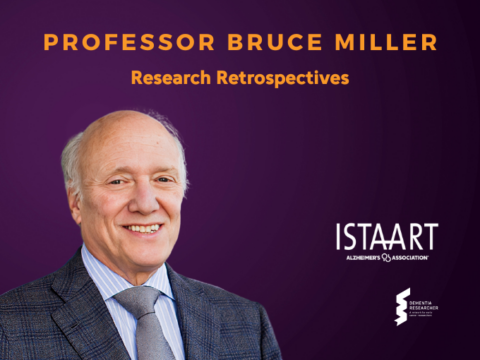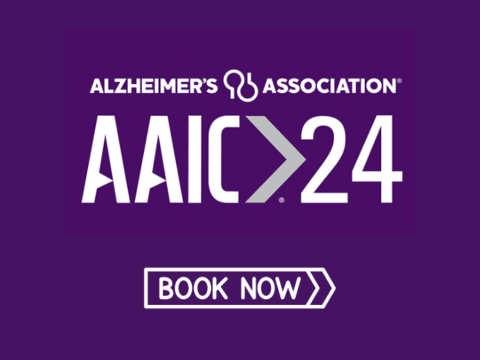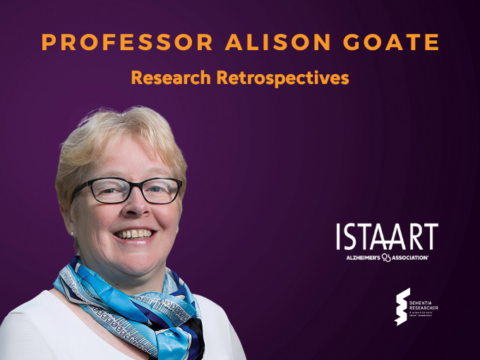The Dementia Researcher, ISTAART PIA Relay Podcast is back for a second, 5-part series. Where the interviewee becomes the interviewer. With five leading researchers discussing their research, their field, and the work of the Alzheimer’s Association ISTAART Professional Interest Area they represent.
Part Two – Professor Zahinoor Ismail interviews Professor Jennifer Whitwell.
Zahinoor Ismail is a Neuropsychiatrist; Professor of Psychiatry, Neurology, Epidemiology, and Pathology at the Hotchkiss Brain Institute and O’Brien Institute for Public Health; Cumming School of Medicine; University of Calgary. Zahinoor works on Dementia prognostication and early dementia detection using non-cognitive markers, treatment of neuropsychiatric syndromes across the cognitive spectrum, pharmacoepidemiology. Zahinoor is representing the Neuropsychiatric Syndromes PIA.
Jennifer Whitwell is a Professor of Radiology at the May Clinic, Rochester having originally grown up and trained in the UK. Jennifer’s research focuses on the investigation of neuroimaging biomarkers, including MRI and PET, in different neurodegenerative disorders, including Alzheimer’s disease and frontotemporal lobar degeneration. She is particularly focused on using neuroimaging to better understand disease mechanisms and progression in patients with atypical clinical presentations of Alzheimer’s disease, highlighting the phenotypic heterogeneity present in this disease. Jennifer is representing the Atypical Alzheimer’s Disease PIA.
The Alzheimer’s Association International Society to Advance Alzheimer’s Research and Treatment (ISTAART) convenes the global Alzheimer’s and dementia science community. Members share knowledge, fuel collaboration and advance research to find more effective ways to detect, treat and prevent Alzheimer’s and other dementias. Professional Interest Areas (PIA) are an assembly of ISTAART members with common subspecialties or interests.
There are currently 27 PIA covering a wide range of interests and fields, from the PIA to Elevate Early Career Researchers to Biofluid Based Biomarkers and everything in between.
To sign-up to ISTAART and a PIA visit www.alz.org/istaart/
Voice Over:
Hello and thank you for listening to the second season of the ISTAART PIA Relay podcast series brought to you by Dementia Researcher. ISTAART is a professional society and part of the Alzheimer’s Association, representing scientists, physicians, and other dementia professionals active in researching and understanding the causes and treatments of Alzheimer’s disease and other dementias. In this five-part series, we once again asked members of the ISTAART professional interest areas to take turns interviewing their colleagues and being interviewed themselves with the interviewee going on to be the next episode’s interviewer. We’ll be releasing one of these podcasts each day in the build-up to the Alzheimer’s Associations International Virtual Conference to showcase the work of ISTAART PIAs. Thank you for listening.
Professor Zahinoor Ismail:
Hello everyone and thanks for joining us. I’m Zahinoor Ismail and I’m a Professor of Psychiatry, Neurology, Epidemiology, and Pathology at the University of Calgary and the Hotchkiss Brain Institute. I chair the Neuro-psychiatric Syndromes Professional Interest Area. Today, I’m delighted to be talking with Jennifer Whitwell. Hello, Jennifer, can I start by asking you to introduce yourself and tell us which PIA you’re involved with?
Professor Jennifer Whitwell:
Yes. Hi. So my name is Jennifer Whitwell. I’m a Professor of Radiology at Mayo Clinic, Rochester, Minnesota and I am actually the Vice Chair, but soon to be Chair of the Atypical Alzheimer’s Disease PIA.
Professor Zahinoor Ismail:
Wonderful. Now, can you tell me, first of all, maybe a little bit about your own research and what brought you to dementia research?
Professor Jennifer Whitwell:
Yeah, so I actually think I kind of fell into dementia research, honestly. So I did a degree in biology in the UK, and then I left university, and I was literally looking for a job, something that involved biology so I could use what I learned in my degree, and I got a job at the Dementia Research Center in UCL London as a research assistant. And then I got the opportunity to do a PhD with them, which was great. So at the time I was just looking for a job that was interesting and involved biology, so that’s what I mean by I kind of fell into it.
Professor Jennifer Whitwell:
And then I think I’ve stayed all these years because it’s just such a fascinating area to work in. There’s always questions to ask, there’s always new technologies to use to assess different aspects of the brain and learn about these diseases. That’s kind of how I started and then now my research really focuses on using neuroimaging, so both MR and PET, to really help understand different neurodegenerative diseases. And then over the last 10 years or so, I’ve really had a focus on looking at some atypical variants of Alzheimer’s disease and using all sorts of different neuroimaging techniques to learn about what’s happening with the proteins in the brain, clinical correlates of those changes to really help us understand the diseases.
Professor Zahinoor Ismail:
Fantastic. What are the hot topics in your field at the moment?
Professor Jennifer Whitwell:
I’ve been thinking a lot about this, I think we really recognized recently, over the last number of years, that there’s a lot of heterogeneity in Alzheimer’s disease, right? So we have different clinical phenotypes of Alzheimer’s disease. People have different symptoms when they come in to the doctor and these patients that have these atypical presentations also have different patterns of neurodegeneration in the brain, they have different distributions of tau proteins in their brain when they die, so there’s a lot of heterogeneity. So I think a lot of work recently has been to try to better understand the mechanisms underlying this heterogeneity, things like genetic associations, even proteinomic association, studies looking at connectivity, how the brain is affected and [inaudible 00:04:12] itself and how that’s related to why the tau proteins are deposited in these regions, and how they spread over time, and how can we explain all this heterogeneity.
Professor Jennifer Whitwell:
Why do we see patients who have these in different clinical phenotypes and the different patterns of degeneration in the brain? Why are we seeing that and how are they spreading? And there’s just been a lot of work in that area from many different fields actually trying to better understand these mechanisms. We don’t really fully understand it yet, but we have techniques that we can use to start just to try to peel it away and better understand what’s happening in Alzheimer’s disease.
Professor Zahinoor Ismail:
It’s funny that you mentioned that, there is that recent paper by Vogel et al. in Nature Medicine, I think led by Oskar Hansson, where they reviewed almost 2000 tau PET scans and determined that in these AD patients that there were four different clinical phenotypes, some of which we anticipated, language variance, posterior, typical, temporal, but also the asymmetric. And to me, that was really interesting because it reminded me of a patient I saw who was bio-marker confirmed AD, amyloid tau positive, but had corticobasal features and trying to reconcile those two in my brain was challenging and it was a real eye-opener, that paper. And I guess very consistent with what you’re saying is that while we have a clinical syndrome that we best guess describes the underlying pathology that it can be really, really varied. So what are the specific type of work that you’re doing, that your field is to really further hone down on this heterogeneity?
Professor Jennifer Whitwell:
Yeah. I mean, that’s a great question and actually that’s the sort of topic of my R01. I have a R01 in atypical Alzheimer’s disease at the minute and we’re doing just that, trying to think on using neuroimaging, because that’s really my background, to look at different mechanisms underlying this heterogeneity. So we’re looking at functional connectivity, I think we’ve found some really nice results showing the different relationships between the way the brain is organized functionally and the different proteins, evidence that amyloid and tau are related to different properties of the functional connectome, and that might determine how they spread. We’ve started to use imaging to look at iron deposition in the brain. Is that playing a role in what’s happening? And I think genetics as well, we’re branching more into genetics to see if there’s any risk loci contributing to this heterogeneity.
Professor Jennifer Whitwell:
And another really interesting aspect of heterogeneity in Alzheimer’s disease is age. There’s a really strong age association in Alzheimer’s disease with younger people having a lot more tau neurodegeneration in their cortex and older people less of that. Also, the other interesting thing that really has come to light in the last 10 years is the contributions of other proteins in the Alzheimer’s spectrum, so that older people with Alzheimer’s disease are more likely to have other proteins in their brain, TDP43, neurovascular pathologies and Lewy body pathologies. The younger atypical patients are less likely to have that. So I think path assessments is super important as well to look at to start to understand this heterogeneity. We have different proteins contributing in different patients along the spectrum of Alzheimer’s disease and those contributions vary with age.
Professor Zahinoor Ismail:
That’s a really insightful point and we appreciate that, to think about it by age. I was also thinking of alpha synuclein, which we’ll see, especially the late onset AD, in the latter half or the latter third of their illness. But to think that the earlier onset patients tend to be probably a little bit more homogenous or proteinopathy pure compared to those who are later on, and especially with AD when other features can really look or contribute to that clinical phenotypic picture. That’s a really helpful point. When it comes to your work then, how would you incorporate age even more so than we do to really look at that? I mean, would you stratify by age? Would you… How would you vary for that to maybe control this heterogeneity? [crosstalk 00:08:45]
Professor Jennifer Whitwell:
Yeah. Yeah, I mean, it depends on the study and it can get very tricky. So we’ve done some studies where we look at correlations with age to see in these studies where we found younger people have more tau in their cortex, and so there age is your main variable and you look at what’s associated with that. Where it gets tricky is accounting for age when you want to look at the difference across phenotypes in Alzheimer’s disease, because the age can vary widely. So if you’re comparing a younger patient to an older patient, it’s very hard to co-vary that age effect out because it’s not just a linear effect of age. You think of aging as well, as you get older you just have more brain shrinkage and more atrophy, but it’s not really that straightforward when your younger patients actually have more neurodegeneration in some regions than your older patients, and you don’t want to remove your disease effects when you’re accounting for age. I don’t know if that really answers your question, but I think it’s-
Professor Zahinoor Ismail:
[crosstalk 00:09:42] No, it does because-Professor Jennifer Whitwell:
… tricky to deal with [crosstalk 00:09:44]. Yeah.
Professor Zahinoor Ismail:
… in some of our studies we’ve tried to, instead of just age on its own, to account for duration of illness, for example.
Professor Jennifer Whitwell:
Yeah.
Professor Zahinoor Ismail:
As another part of that variable, because that might then incorporate, or age of onset, either or, to incorporate some of those features, but the way you describe it really crystallizes it. With respect to your PIA then, how does the PIA contribute to your work specifically and to this body of work globally?
Professor Jennifer Whitwell:
Yeah. I think we’ve been trying, we’ve done a number of things that we think are helping support the atypical AD field. I mean, the first is just providing a scientific session that’s focused on atypical Alzheimer’s disease, a place where people can come, and present their work, and discuss issues related to atypical AD. I think abstracts on atypical AD syndromes can get lost in the main meeting and maybe don’t get so much of a chance to get oral presentations because there’s so much in more the typical Alzheimer’s. I’m not really sure even how to describe typical AD anymore, but in that sort of typical AD field, so I think abstracts can get lost. So I think it’s nice, it’s really nice to have that little session where we can all get together and talk about issues.
Professor Jennifer Whitwell:
We also have a featured research symposium at AAIC. We had one last year and we have another one this year. So that really focuses on heterogeneity across Alzheimer’s disease and atypical AD. And we’ve started a webinar series really aiming to give educational webinars. We had a year in review webinar, I was going to say earlier in the year, I think it was the end of last year, which was really well received and well attended and that was just a really nice review of work in atypical AD over the preceding year. So we’re going to continue to do those and we’re also planning some educational webinars that go through some of the different clinical syndromes associated with atypical AD, talk about issues that pertain to those syndromes, look at other neuroimaging and other findings, really just sort of provide a nice educational series.
Professor Jennifer Whitwell:
We also send out newsletters. We put newsletters out to our membership a few times a year, which talk about the work of the PIA and then also some general notable publications in atypical AD and issues related to atypical AD. And we’ve also started, and we were going to continue this, collaborating with other PIAs. So we focus on atypical Alzheimer’s disease, but there’s so much overlap with some of the other PIAs, particularly in the neuroimaging PIA, or many other PIAs. So we have had a collaboration with a neuroimaging PIA where we had a little session in their AAIC day session back in 2019, I think, or was it? Yeah, it was last year, and then they are going to have some abstracts in our session this year. So we’re going to try and really establish more collaborations across PIAs to really bring fields together, and to increase education on atypical AD across other PIAs that may not know so much about it.
Professor Zahinoor Ismail:
So it seems that given that the atypical dementias are relatively less frequent compared to what we might see as more typical or classical phenotypic AD, your work is extensively through the PIA around educating PIA members, as well as other PIAs and groups on the nature and extent of these illnesses. Is there collaborative research going on within the PIA amongst the different members and is the PIA kind of fostering that generation of research ideas, which are then implemented by different members?
Professor Jennifer Whitwell:
Yeah. One sort of study that was sort of started by the PIA is a white paper on posterior cortical atrophy, which is one of the atypical AD syndromes, really led by a group in London so we’ve really been supporting that. And I think that they are close to being finished this year, so they were really looking at what are the symptoms, trying to better define posterior cortical atrophy, and look at symptoms that people observe in this disease, and try to really just help with diagnosis and definition. So we’ve been supporting that effort, which would give us a white paper and I think we really need to strive to do more, I think, as a PIA, more collaborations within us and there’s so many things in the field that need better definitions and collaborations are going to really help with that.
Professor Zahinoor Ismail:
Yeah. I agree. The PIA white papers I think are very helpful and when I see them I’m… and the expertise that generates them, they’re very valuable documents, informative, and move the field forward. With respect to then inter-PIA collaborations, and as a representative and a chair of the neuropsychiatric syndromes PIA, to what extent is the discussion in the atypical dementias in the PIA colored by behavior, for example.
Professor Jennifer Whitwell:
Behaviors, we don’t see a lot of work coming through the PIA really looking at, I’ll be honest, clinical aspects of atypical AD. We see a lot of neuroimaging work and that’s where I focus too. We have recently started to look at some, do we see behavioral abnormalities in these atypical variants? And you absolutely do. And in the last year or so, we now have a behavioral variant of Alzheimer’s disease that’s been better defined. There’s a paper out there on the behavioral variant. So you really can see patients that present sort of with a behavioral variant of frontotemporal dementia, but end up with an Alzheimer’s pathology. So there’s definitely increasing recognition of that and I think our broad spectrum of what we consider atypical Alzheimer’s disease is widening.
Professor Jennifer Whitwell:
We also have a dysexecutive syndrome of Alzheimer’s disease and I think we’re going to realize that some of these syndromes are more common than we first thought. A lot of my research has been on the logopenic variant of logopenic progressive aphasia language variant of Alzheimer’s disease and posterior cortical atrophy, but we really have a widening definition of what atypical AD is. And with the corticobasal syndrome, like you mentioned as well, it’s very heterogeneous and there’s a lot of overlap between a lot of those syndromes as well, which I think we need to better look into and better think about when we define them. What are the criteria we’re using for a language variant of Alzheimer’s disease, or the corticobasal syndrome, or practice variant of Alzheimer’s? I think we need to, with more work that needs to be done looking at overlap between them and people don’t always fit nicely into categories.
Professor Zahinoor Ismail:
I would agree. I think the language variants for me are the hardest to really nail down because the sort of clinical acumen or the ability to detect changes in language, it’s challenging. And I see patients they can look logopenic, they can look semantic, they can look… It really varies.
Professor Jennifer Whitwell:
Yeah.
Professor Zahinoor Ismail:
I would imagine that there especially, the imaging, the biomarker findings are really going to help when the clinical picture is challenging. I’m certainly much more likely to obtain biomarkers in that population just because sometimes I’m not always sure. You also mentioned the posterior cortical syndrome and in the context of behavior, I think some of the most agitated patients I’ve ever seen were those that had blindness and the NPCA, and just so tragic to see people lose their eyesight and kind of wander through the system, changing their glasses numerous times, and seeing optometrists and ophthalmologists, and the diagnosis being so delayed.
Professor Zahinoor Ismail:
I also see PCA as one of those areas where AI might help generate interesting models because it seems like the AI models already are looking at visual recognition and categorizing flowers and trucks into super categories or differentiating between subtypes. And probably in terms of our neurodegenerative diseases, PCA is the one that probably best harmonizes with the AI world. So I think there’s probably room for a lot of interaction there and then also with imaging studies, as you do. How is machine learning and AI taking hold in your line of research?
Professor Jennifer Whitwell:
Yeah, I think it’s definitely blossoming, my goodness. There is a lot of focus on machine learning techniques to better characterize disease, subtype disease. I mean, I think studies have shown there’s various different subtypes even within posterior cortical atrophy that have different… I mean, I would mainly know about the imaging type of AI studies, but there’s different anatomical variants even within these syndromes. So I think it’s going to be incredibly helpful as time goes on. I think there’s a lot of interest in it and a lot of studies coming out. I think for me, it’s knowing how to take the AI approaches and lead it back to something clinically useful at the end, so it’s not sort of a black box. It gives you an output, something that really could be utilized and be used in the clinic, which I think people are for sure working on to really turn those findings into something that can help with diagnosis, or prognosis, or tracking progression.
Professor Zahinoor Ismail:
Is there representation of that kind of expertise in your PIA, for example?
Professor Jennifer Whitwell:
Yeah, there is. I mean, within our… Maybe I’ll tell you a bit about who’s in our PIA. So I [crosstalk 00:19:52].
Professor Zahinoor Ismail:
That’s precisely where I was going.
Professor Jennifer Whitwell:
Yeah, a little bit of a rundown of our PIA. So our current Chair of the PIA, Femke Bouwman, she’s from Amsterdam. Like I said, I’m the Vice Chair, but I’ll be taking over from Femke to start the AAIC and then our current Immediate Past Chair is Melissa Murray from Mayo Clinic, Jacksonville. So our current… Actually, we’re doing a little bit of musical chairs in our PIA at the moment. Our current program’s Chair is Rik Ossenkoppele from Amsterdam. He has a lot of experience in imaging and utilizing these types of techniques we’ve been talking about, and he’s actually going to transition into the Vice Chair role after AAIC. And our Communications Chair, Keir Yong, from UCL, and he puts out and writes the newsletters, the great newsletters for us, and he’s going to become the Program’s Chair after AAIC.
Professor Jennifer Whitwell:
So it’s like… Like I said, we’re doing some musical chairs. We have a great Junior Trainee, Baayla Boon, also from Amsterdam, but she’s currently doing a fellowship with Melissa Murray in Jacksonville and she is going to become the Communications Chair after AAIC, so we’re switching around. And then we have a new Junior Trainee, Rosaleena Mohanty, from the Karolinska Institute in Sweden, so that’ll be great. She’s joining us and she’s going to take over the Junior Trainee role right after AAIC. So a lot of switching around our positions and a lot of changes in the committee coming, but we are managing to keep a lot of the core group together and I think we’re going to really be able to do a lot over the next couple of years.
Professor Zahinoor Ismail:
No, that’s fantastic. It sounds like the institutional knowledge will remain within the PIA, but with just a transition to greater responsibility for people who have been there.
Professor Jennifer Whitwell:
Yes, and different responsibility just slightly. Yeah. Yeah.
Professor Zahinoor Ismail:
Now, how can early career researchers who are listening become involved with your PIA?
Professor Jennifer Whitwell:
Yeah. I think for early career researchers the thing is to join ISTAART and join our PIA, join the membership of the PIA, and then they can receive the newsletters, they can attend the webinars, the educational webinars, which I think will be great. They can apply for positions on the committee when they become available, especially the Junior Trainee position would be great for somebody coming in. They can also… I’d really encourage them to submit abstracts to our scientific session. We love to see abstracts from junior investigators and give them a platform and a chance to present their work. We also have a business meeting right after our scientific session, which I also think is a great thing to come along too. We’ll be talking about the aims, goals of the PIA, and people can tell us what they think and what they would like to see us do over the next year or so. So I think all of those things, but start by becoming a member of the PIA, and then you’ll get the communications, and there’ll be a more clear way to get involved.
Professor Zahinoor Ismail:
Excellent, and it seems like junior members are really participating in that communication and-
Professor Jennifer Whitwell:
Yes.
Professor Zahinoor Ismail:
… to help provide that level of comfort for junior career and trainees, because I find in my experience that they’re sometimes a bit shy. I mean, you have a who’s who of atypical dementia in your PIA so it’s potentially intimidating. It’s nice to see that there’s space for them and that they’re welcome to participate.
Professor Jennifer Whitwell:
Yeah, I think it’s great that we have the Junior Trainee roles. I think it’s really important to get the younger generation and the junior investigators involved right from the beginning so that they feel comfortable in the field, and with everybody, and really you can start to see their work.
Professor Zahinoor Ismail:
Fantastic. Now, as we wrap up, I’d like to ask you one final question, unless you have more to add to the topic. What advice would you give to any aspiring dementia researchers out there who are thinking of looking into dementia?
Professor Jennifer Whitwell:
Yeah. I thought a lot about this one too and I think the thing is to have a thick skin. I think that’s what it is. When you come in as a junior investigator, you will write papers and you will put grants in that will get rejected. It’s going to happen and you need to not be disheartened and you need to keep plugging at it, I think. No matter how good your papers or grants are, they will get rejected. It will happen, but you just have to keep trying and keep persevering, not take it personally, and yeah, that’s it I think. You just keep trying and you will get there. Even the best grant you ever write could… It doesn’t mean it’s going to get funded, so you just have to keep trying.
Professor Zahinoor Ismail:
I think those are great words of wisdom, not only for junior trainees, but for all of us.
Professor Jennifer Whitwell:
Yes.
Professor Zahinoor Ismail:
The infamous reviewer too, helping us withstand those comments when they may or may not be accurate is helpful for every single scientists out there and certainly to advise our junior trainees that it gets better with time.
Professor Jennifer Whitwell:
Yeah, and it happens to all of us. It doesn’t matter how many years we’ve been in this field. We will still get grants that won’t be scored, still get grants that are rejected, still get papers rejected. It doesn’t matter what stage you’re at it still happens so you should get used to it early and-
Professor Zahinoor Ismail:
That’s right.
Professor Jennifer Whitwell:
… not take it personally.
Professor Zahinoor Ismail:
Wonderful. Thank you for the fantastic discussion and Jennifer, for joining us today. And I look forward to interacting with you more virtually in our case at AAIC. Thank you.
Professor Jennifer Whitwell:
Yes. Thank you so much. We should do a collaboration across our peers too.
Professor Zahinoor Ismail:
Exactly. I was thinking the same.
Professor Jennifer Whitwell:
Great.
Professor Zahinoor Ismail:
Wonderful.
Voice Over:
Thank you for listening. You can find profiles on today’s panellists and information on how to become involved in ISTAART on our website at dementiaresearcher.NIHR.ac.uk, and also at alz.org/ISTAART. We’ll be back tomorrow with the next recording in our ISTAART PIA Relay podcast series. Finally, please remember to like, subscribe, and leave a review of our podcast. You can do this on our website and in your podcast app. Thank you.
Voice Over:
Brought to you by dementiaresearch.nihr.ac.uk, in association with Alzheimer’s Research UK and Alzheimer’s Society, supporting early career dementia researchers across the world.
Voice Over:
Hello, this is Adam Smith. I’m just dropping into the podcast stream to ask you a favor. Dementia Researcher has been nominated for a People’s Choice Podcast award and it would be fantastic if you would take a moment to vote for us. You’ll find the link in the text below the podcast and if you visit podcastawards.com, register an account, and you’ll find Dementia Researcher in the Science and Medicine category. Choose us, hit submit, job done. Dementia Researcher is a real passion of mine. I so enjoy producing the podcast and occasionally hosting as well. All of our guests give up their time freely and I think this would be a fantastic way to recognize their contribution and to help put important dementia research on the map. So please, if you have a moment, it would be fantastic if you could take the time to vote. Thank you very much for listening and again, click the link in the text below or go to www.podcastawards.com by the 31st of July. Thank you.
END

Like what you hear? Please review, like, and share our podcast – and don’t forget to subscribe to ensure you never miss an episode.
If you would like to share your own experiences or discuss your research in a blog or on a podcast, drop us a line to adam.smith@nihr.ac.uk or find us on twitter @dem_researcher
You can find our podcast on iTunes, SoundCloud and Spotify (and most podcast apps) – our narrated blogs are now also available as a podcast.
This podcast is brought to you in association with Alzheimer’s Research UK and Alzheimer’s Society, who we thank for their ongoing support.

 Print This Post
Print This Post




